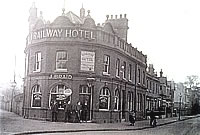Teddington
...belonged to Benedictine monks...

A number of flint and bone tools and weapons from the Mesolithic period (about 7000BC) have been found at Teddington. Neolithic (3000-4000BC) finds have been made in Bushy Park. Teddington also had a Bronze Age Barrow in Sandy Lane which was excavated in 1854 and a fine bronze dagger was found, although both have since disappeared. There is little evidence of Roman occupation in the area, although there have been some unauthenticated finds. They also have been lost.
Teddington is a name derived from the Anglo-Saxons. The ton element of the name means a settlement. The first element derives from Tuda's people. The manor of Teddington belonged to Benedictine monks in Staines, and it is believed that it was they who first built a chapel dedicated to St Mary on the site of the present church. In a charter of 971AD the land at Teddington and other places was granted to the church of St Peter at Westminster (Westminster Abbey).

Teddington is not mentioned separately in the Domesday survey, being included in the Hampton entry. In the 17th and 18th centuries many wealthy businessmen retired to large houses in Teddington, although it did not become as fashionable as Twickenham.
Teddington remained a rural farming area until the arrival of the railway in 1863. The main shopping centre is divided by the line, with High Street to the east and Broad Street to the west. After this the manor and most of the farms were sold and developed for housing. As a result, the population of 1,200 in 1861 had risen more than ten-fold to 14,000 by 1901. A Local Board was established in 1867, and this became an Urban District Council in 1895.



